A 421 status code, also known as HTTP 421 Misdirected Request, is an HTTP status code that indicates that the server can’t establish a connection with the client due to network or configuration issues. The server understands the request, but it refuses to process it because it doesn’t have the ability to do so.
This status code is often used when the server is configured to use HTTP/2 connection reuse and the incoming request has been directed to the wrong service or endpoint. It’s used to indicate that the client should not repeat the request on the same network connection, as it might repeat the same mistake.
When a client, such as a web browser, sends a request to a server to view a website, the server may return a variety of status codes based on whether the request was successful or not.
421 is one of these status codes, signaling a problem that is typically temporary in nature. The client can close the current connection and open a new one for the next request to the server.
From a technical standpoint, a 421 status code might occur for several reasons:
- Too many connections. If a client opens too many simultaneous connections from the same IP address, the server may refuse to form a connection, returning a 421 status code.
- Connection reuse. In the HTTP/2 protocol, a single connection can be used to send multiple requests from a client to a server. Sometimes, a client might mistakenly send a request intended for one origin (e.g., a specific website or server) to another origin over the same connection, causing the server to return a 421 status code.
Understanding HTTP status codes and protocols is crucial in managing and optimizing a website. If a website is returning a lot of 421 status codes, it can be a signal of issues with the server or network configuration that need to be addressed. If not properly handled, this could result in the website being less available or accessible to users, potentially impacting the site’s SEO performance.
421 Status Code and SEO
A 421 status code, like any HTTP status code, can have an impact on a website’s SEO if not properly managed. Search engines, like Google, value the quality of user experience, which includes the speed and availability of a website.
Here’s how 421 status codes could affect your SEO:
| Website Availability | A high number of 421 status codes indicate availability issues on your website. Search engine crawlers, like Google’s Googlebot, may interpret these as a sign of an unstable or poorly configured site. This could lead to a reduced crawl rate as the search engine bot might start avoiding your site, resulting in less of your content being indexed and a lower ranking in search results. |
| User Experience | From a user perspective, encountering a 421 status code can be disruptive and frustrating, leading to a poor user experience. A user may navigate away from the website if it’s not readily available, increasing your site’s bounce rate. This can indirectly influence your SEO as search engines consider user behavior data as one of the ranking factors. |
| Website Speed | If your site often returns a 421 status code due to excessive connections, it could slow down the site’s load time. Page speed is a known ranking factor, and slow-loading pages could negatively affect your site’s ranking in search engine results pages (SERPs). |
It’s important to monitor your site for 421 status codes and to address them promptly when they appear. This might involve refining your server’s connection management strategy, upgrading your server’s capabilities, or configuring your site’s code to reduce simultaneous connections from a single client.
By doing so, you can improve your site’s availability, speed, and, ultimately, its SEO.
Identifying 421 Status Codes
Identifying 421 status codes can be done using various methods. Here are a few tools and techniques you can use:
- Server Logs. Server logs are the first place to check when investigating HTTP status codes. These logs will tell you about each request made to your server and the response code that was given. Look for entries with ‘421’ to see if your site is regularly returning this status code.
- Website Crawlers. Tools like Screaming Frog SEO Spider, DeepCrawl, or Botify can crawl your website, mimicking the process used by search engine bots. These tools can provide a detailed report of the HTTP status codes returned by each URL on your site.
- HTTP Status Code Checker. Online tools like HTTP Status Code Checker can help you check the HTTP status code for individual URLs. It’s a straightforward tool where you input the URL, and the tool will return the HTTP status code.
- Google Search Console. Google Search Console (GSC) is a tool from Google that helps you monitor and troubleshoot your website’s presence in Google Search results. GSC provides a coverage report that displays the status of all indexed pages on your site, including any pages with errors.
- Chrome Developer Tools. You can use your browser’s developer tools (like in Google Chrome) to see the HTTP status codes of individual requests made while loading a webpage. By opening the ‘Network’ tab in developer tools and reloading the page, you can see a list of all requests made. Each request’s status code is displayed, allowing you to identify any 421 status codes.
Remember, if you identify 421 status codes on your website, it’s important to investigate and fix them as soon as possible to maintain the best possible site performance and SEO.
421 Status Code Common Issues and How to Fix Them
Understanding and fixing the issues causing a 421 status code is crucial for maintaining a smooth user experience and solid search engine rankings. These errors can stem from various reasons, each requiring a specific solution.
Let’s dive into the most common issues leading to 421 status codes and explore how to address them.
Excessive Connections
When there are too many connections being attempted from the same IP address, the server may return a 421 status code.
Also, if you have control over the server settings, consider scaling up server resources or upgrading your hosting plan to better handle multiple connections.
Misconfiguration of HTTP/2 Protocol
HTTP/2 allows multiple requests and responses to be sent on the same connection. However, if these requests are not managed properly, it can lead to a 421 error.
Issues with Load Balancers or Reverse Proxies
Load balancers or reverse proxies can sometimes direct requests to the wrong server, causing a 421 error.
Using an Outdated Browser
Older browsers that don’t fully support HTTP/2 could potentially cause 421 errors.
Faulty SSL/TLS Configuration
Incorrect SSL/TLS configuration can lead to 421 errors, as it can cause the server to reject the connection.
Remember, it’s important to regularly monitor your website’s status codes to ensure optimal performance and user experience. Tools like Google Search Console, Website Crawler for Technical SEO Analysis by Sitechecker, or other SEO software can be invaluable for identifying and addressing HTTP status code issues.
Detect 421 HTTP Status Code Issues with HTTP Status Code Checker

SiteChecker Pro offers an HTTP Status Codes Checker, which helps in quickly detecting 421 errors by returning the HTTP status code of any entered URL. It’s a valuable initial step in identifying and resolving any website issues that could impact performance and SEO.
In addition to the status code checker, SiteChecker Pro features a website crawler that scans your site for SEO problems, including 421 errors. This enables a thorough, site-wide check to ensure no problematic status codes are missed, thus preserving a high-quality website.
The platform is also user-friendly, providing not only problem detection but also practical solutions to fix the issues. Using SiteChecker Pro regularly aids in maintaining your website’s health and performance, making it an essential part of your SEO routine.
Conclusion
Understanding and managing the 421 HTTP status code is crucial for optimizing website performance and SEO. This code signals network or configuration issues, and persistent errors may affect a site’s availability, user experience, and loading speed – all important factors for SEO.
Tools like server logs, website crawlers, Google Search Console, and SiteChecker Pro can help identify and address 421 errors. SiteChecker Pro, in particular, is valuable for quickly detecting these errors and performing a comprehensive site-wide SEO check.
Common issues causing 421 errors include excessive connections, misconfigured HTTP/2 protocols, faulty load balancers, outdated browsers, and incorrect SSL/TLS configurations. Regularly monitoring your website’s status codes and promptly addressing issues can improve website performance and SEO rankings.





